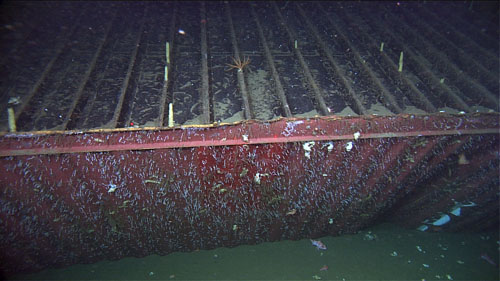You can read the daily cruise logs here
CRUISE BACKGROUND
December 6, 2013
Monterey, CA

Resting on the seafloor almost a mile below the surface of Monterey Bay lies a large shipping container, just one of 24 such containers that were lost at sea off the cargo ship M/V Med Taipei during a storm in February 2004. The ship was transiting from San Francisco to Los Angeles. This container was discovered by the Monterey Bay Aquarium Research Institute (MBARI) in June 2004, however, the locations of the other 23 containers remain a mystery.
This was not an isolated incident. Containerized maritime trade grew eight-fold from 1985 to 2007, and worldwide there are now approximately 5 to 6 million containers in transit at any given moment. Estimates of the number of shipping containers lost at sea range from the hundreds to the thousands, often due to the nexus of rough seas and inadequate or faulty securing mechanisms. Many containers are not weighed prior to loading, resulting in extreme forces being placed on container stacks when bad weather strikes. Depending on their cargo and the integrity of containers, they may float at the surface for several days or weeks prior to sinking. Unfortunately, it is not mandatory to report container losses to all relevant management agencies.
In March of 2011, the Monterey Bay National Marine Sanctuary (MBNMS), along with MBARI, used a deep-sea remotely-operated vehicle (ROV) to document the state of the container and its impact on the local ecology. This initial study showed an adverse affect to seafloor life of an area greater than 20 times its footprint. A mini-documentary about the 2011 research cruise can be viewed on YouTube, and more detailed project information can be found on the Sanctuary Integrated Monitoring Network as well as photos from the 2011 expedition.
MBNMS and MBARI will re-visit the container during a research cruise aboard the research vessel Western Flyer from December 11-16, 2013, once again led by Dr. Andrew DeVogelaere and Dr. Jim Barry. High-definition cameras aboard the ROV “Doc Ricketts” will become the scientists eyes, while the robotic arm and variety of collecting containers aboard the ROV will enable scientists to retrieve both animal and sediment samples for further analyses as well as place additional in-situ experiments. The main goals of this second visit to the container are:
- Assess the container’s current condition by gathering high-resolution imagery
- Describe sea life on the container and at different distances from it, to assess impacts
- Assess toxicity of paint that has chipped off of the container
- Set up an experiment to test the effectiveness of new types of container paint, that are designed to be environmentally friendly
- Continue to bring public attention to this deep-sea phenomenon that has been increasing with economic globalization and increased shipping

Although the visit to the shipping container is the highlight for MBNMS research staff, MBNMS will also be assisting Dr. Jim Barry in MBARI’s ongoing benthic ecology studies. These long-term studies are trying to determine whether deep-sea animals are more sensitive to climate change and ocean acidification than shallow water animals. More information about MBARI’s deep-sea benthic ecology studies can be found here.
The public can follow this exciting expedition with daily cruise logs posted to this page, as well as the MBNMS Facebook Page, Office of National Marine Sanctuary’s Facebook Page, and MBARI’s Benthic Ecology cruise logbook.
A video production of this research expedition will eventually air on “Your Sanctuary TV” in 2014. You can visit YourSanctuaryTV.org for past episodes.